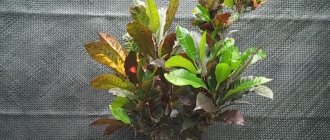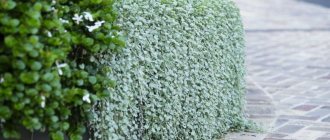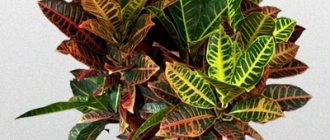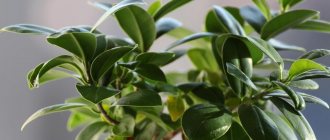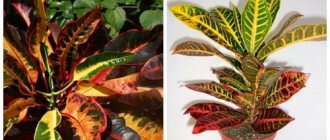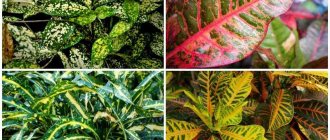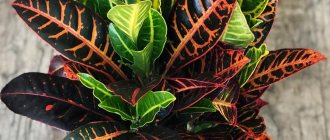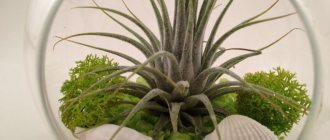Home » Indoor plants » Decorative foliage plants
Published: 10/31/2018
Codiaeum belongs to the Euphorbiaceae family. Native to East India, Malaysia, Sunda and Molluk Islands. Its peculiarity is the presence of milky juice, which soaks the stems and leaves, helping the plant heal any damage and infections. Flower growers often use another name - croton.
- 1 Description
- 2 Varieties for indoor breeding - table
- 3 Home care 3.1 Seasonal table
- 3.2 Transplantation: pot, soil, step-by-step description
- 3.3 Formation, support
Varieties for indoor breeding - table
At home, of the entire species diversity of croton, only one is grown - verigate (variegated), but the varieties bred on its basis are not inferior in color originality.
| Varieties | Leaves and other features |
| Variegatum | Large, length - 30 cm. A variety of shapes of leaf plates from a yellow-green color scheme, varying depending on lighting and other factors. The stem is straight, without foliage below. This is the founder of all decorative hybrids. In the house it grows up to 70 cm. |
| Petra | Thick, shiny, light green in color with yellow edges and veins. The shape is similar to pointed blades. The stem is branched. |
| Tamara | Elongated oval with uneven edges, unusual coloring - pink, purple or yellow spots are scattered on a white-green background. Hybrid. It reaches a height of one meter. Rare variety. |
| Mammy | Twisted, long, curly, variegated in color. |
| Mrs Eyeston | Long, wide, rounded at the ends, brightly colored - yellow, red, pink and gold. Tall tree variety |
| Black Prince | So dark green that they appear black. Red, yellow, and orange spots are scattered on wide dark ovals. |
| Excellent | They resemble oak trees, the front side is yellow-green, the back is burgundy-red. Low bush. |
| Disraeli | Lobed green, veins yellow, bottom brick-brown. |
| Zanzibar | Very narrow and long, falling like a green, yellow, red waterfall. Looks impressive in hanging baskets. |
| Aucubifolia | Small narrow, green with yellow uneven splashes. |
| Sunny Star | Narrow, dark green, blooming at the tips with yellow and lemon hues. |
| Three-cavity | Consist of three parts with gold veins. |
| Eburnaeum (white chimera) | Creamy shade. With bright diffused lighting and constant spraying, it can please you with burgundy colors. |
| Splashes of champagne | Narrow oblong, dark with yellow splashes. |
The mix is a varietal variety of croton.
What are beautiful flowering plants?
Beautifully flowering plants are again a term purely for flower growers. It is very important to use this term correctly. Not just blooming, but beautifully blooming. After all, you must agree that the flowers of arrowroot, sansevieria, croton, etc. are uniquely beautiful, but they cannot be compared with azaleas, roses, hibiscus, gardenias, etc. That is, beautifully flowering ones are grown solely for the sake of flowering.
Schefflera flowering
Home care
The plant is quite finicky, but if you create the right conditions, you can achieve diversity and brightness throughout the year.
Seasonal table
| Parameter | Spring Summer | Autumn winter |
| Location/Lighting | Prefers eastern and western windows with bright but diffused lighting. | It is best to choose a south window. With light starvation, the leaves will begin to lose their bright color; lighting is necessary. |
| Temperature | Comfortable - +20…+24℃. At +30℃, shading and increased humidity are necessary. | Avoid temperature changes. Acceptable - +18…+20℃, not lower than +16℃. |
| Humidity | Increased. In summer, constant spraying with warm, settled water. It is good to place the container with the flower in a flowerpot with a damp filling (pebbles, expanded clay). | Spraying is reduced. But during the heating season, it is necessary to monitor the saturation of moisture in the air near the codiaum. |
| Watering | Frequent, good. But the soil should dry out to a third of the container. The water is warm and settled. | Reduce. |
| Feeding | Once a week - alternating complex mineral and organic fertilizers | Reduced - 1 time per month. |
Transplantation: pot, soil, step-by-step description
Codium is transplanted in the spring. Young (1-3 years) - annually, adults (over 3 years) - once every 2-4 years.
The pot should be shallow, slightly wider than the container in which the flower was before transplanting. Since its roots grow, they interfere with the development of foliage. For young croton, you can use plastic, but for older croton, a clay ceramic pot is preferable so that the soil inside can breathe.
Drain holes are required.
The soil needs to be slightly acidic. The finished universal soil is diluted with fine-grained drainage, perlite and charcoal. Self-cooking:
- young growth: humus, turf, coarse sand (2:1:1);
- adult croton - (3:1:1).
Transplantation is a step-by-step process:
- The soil is pre-watered.
- The new container is filled with drainage (three centimeters) and a small amount of soil mixture.
- Using the transshipment method, they take out the codiaum, place it in the middle and add soil.
- Watered.
- Place the flower pot in a place with sunny but diffuse lighting. Moisturize daily.
It is better to replant a new flower after a month.
To improve the adaptation process, croton is sprayed with a growth stimulator (Epin).
Formation, support
To create a more luxuriant crown, young plants are pinched. At the beginning, 15 cm, as it grows - 20 cm. Pruning is carried out in the spring.
If after the procedure the codiaum stops growing, this is a temporary phenomenon. After some time it will branch.
For an adult croton, with a lot of foliage and an insufficiently strong trunk, support is needed. In the beginning, you can use bamboo or wooden sticks. You can also purchase special devices for vines, or make them yourself.
Pruning and crown formation
The side shoots of croton grow more slowly than the central stem. Therefore, it is important to shape the crown of the flower so that the bush grows lush. Perform the first pinching of the plant when the codiaum reaches a height of 15 cm. This will provoke increased growth of side shoots. Repeat pinching when the branches grow 20 cm in length.
In the future, regularly shorten shoots that are too elongated and remove dried leaves, damaged and weak branches. And also cut out flower buds, because they drain the plant’s strength. After the procedure, be sure to sprinkle the cut areas with crushed charcoal.
Errors in care and their elimination - table
Croton's appearance will indicate improper conditions of detention and mistakes in caring for it.
| Type of lesion | Reason for appearance | Elimination method |
| The foliage is turning pale. | Lack of lighting. | Place close to the light, but protect from bright sunlight. In winter, use artificial lighting. |
| Dry brown specks. | Sunburn. | Hide from sunlight. |
| The leaves are curled, the ends are brown but soft. | Temperature changes. | Monitor the temperature during the day and at night. It shouldn't be drastically different. |
| Brown and brown edges of leaves. | Lack of watering. Dry air. Drafts. | Provide everything:
|
| Drooping leaves, loss of elasticity. | Lack of watering. Freezing of roots. | Water regularly with warm water. Place in a bright and warm room. |
| Leaf fall. | Croton is getting old. Excess moisture in winter. Very dry or cold atmosphere, drafty. | Follow the codeum: With normal growth of young leaves, this is a common occurrence. If young growth is suffering, eliminate all shortcomings. |
| Redness of the leaves. | Nitrogen starvation. | Use fertilizers containing nitrogen. |
| The back of the leaf becomes white and fluffy, the top becomes brown. | Temperature too low. Overwatering. | In winter, if there is a lack of heat, water with warm water after the soil has dried to one third of the volume of the pot. |
| Yellowing. | Lack of nutrition. Overwatering. | Apply fertilizer as it grows. Follow watering rules. |
| Red spots on the back of leaves. | Excess sun. | Shade in midday sun. |
Frequently asked questions about growing croton?
- Why doesn't croton grow?
Poor growth of croton is usually due to poor lighting. Light is critical for the growth of croton, so in winter it grows much worse than in summer.
- Why do croton leaves dry out?
Croton leaves will not dry out if you regularly water the plant, do not leave the soil dry and monitor air humidity. It is worth remembering that poor moisture can lead to the appearance of parasites and other troubles.
- Why does croton shed its leaves and what to do?
There is no need to worry if the croton periodically sheds its leaves - this is a natural process for many plants, but if the croton sheds many leaves at once, this may be the result of poor watering, insufficient air humidity, sudden temperature changes, unfertilized soil or spider mites.
- Is Croton poisonous?
Croton juice is poisonous. Its entry into the gastrointestinal tract causes vomiting and loose stools, and contact with the skin can cause dermatitis. You should handle the plant carefully, and it is recommended to wash your hands after any operations with it.
Diseases, pests - table
| Manifestation | Disease, pest | Fighting method |
| The appearance of brown spots. Codiaum does not grow and dries out over time. | Fungal disease | Remove diseased leaves. Place the codiaum in a weak solution of potassium permanganate. Replace the soil. Treat Croton with Fitosporin solution. In case of severe damage, use Speed. |
| Yellowing and falling leaves, softening of roots. | Root rot | Only at the beginning of the disease is it possible to save croton:
Protected light and infrequent watering are required until new leaves appear. |
| The appearance of yellow spots, white cobwebs. The leaves are withering. | Spider mite | Remove diseased leaves. Spray with Fitoverm, Actellik. |
| Convex, dark spots on the back of the leaf. | Shchitovka | Remove the pest. Spray with Actellik. Repeated treatment until the insect disappears. |
| The leaves are sticky, a whitish coating appears, and growth stops. | Mealybug | Treat with insecticide repeatedly. |
Reproduction
get new plants using cuttings throughout the year. To do this, the apical young or lignified shoot up to 10 centimeters in length is cut off from the mother bush. The milky juice is removed from the cut site and the wound is treated with crushed charcoal. After this, the cut site is treated with a root-forming composition and placed in a nutrient substrate.
The soil for codiaum should consist of peat and sand in equal volume parts. To quickly form roots, containers with cuttings are placed in a warm room with a temperature of 22-24 degrees. Caring for seedlings involves periodically watering the soil and spraying the plants.
An easier way to obtain new crops is
leaf propagation.
In this case, a large leaf is taken from the mother bush, the milky juice is collected from it and dipped in water, and the cut area is rubbed with charcoal.
Next, the leaf is rooted in a moistened nutrient substrate of peat and sand. The vegetative organ is placed under a film, periodically ventilated and moistened. After the seedling has several stems, it is moved to a separate pot.
Description
In reality, Croton and Codiaum are different plant species, the first of which includes about 1200 species, and the second only 17.
Representatives of the Croton species are common in tropical regions of all continents. The range of Codiaum is many times smaller: Indonesia, Malaysia, Australia and the western islands of the Pacific Ocean.
In the USA and Europe, Codiaum variegata is called garden croton, which helps avoid confusion. For some reason, our variegated codiaum has become just a croton.
Fortunately, representatives of both species grow in fairly similar natural conditions - care errors made due to confusion of names are most likely not serious.
However, why take the risk? When caring for codiaum Petra, it is worth considering that the plant is not actually croton , although it has common features with it.
Codiaum Petra is a fairly large plant. Sometimes the height of the stem reaches 4 meters . Large smooth leaves are arranged alternately on straight branches, but very densely on all sides.
The shape of leaves on the same plant can be oval or round with or without a sharp tip. The color, as a rule, is also varied : the surface of the leaf itself can be dark green, and the veins have a scarlet hue and many other variations.
It was the variety of many shades on the same plant that gave rise to the name Codiaum variegated. Also very popular among flower growers are such types of Codiaum as: Excelent, Tamara.
